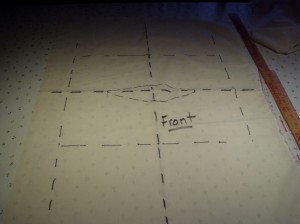 In our last episode, we discussed Frida Kahlo, zero-waste clothing and her wearing of indigenous, traditional clothing, as an introduction to making clothing which is less wasteful of fabric, less wasteful of resources, with the first example being what has almost become (besides Kahlo’s crown of braids with flowers woven in) the icon for Kahlo: the Huipil, her seemingly favorite form of blouse. Even in photographs where she is (gasp) wearing pants, she is still wearing one of these colorful, simple tops. (more…)
In our last episode, we discussed Frida Kahlo, zero-waste clothing and her wearing of indigenous, traditional clothing, as an introduction to making clothing which is less wasteful of fabric, less wasteful of resources, with the first example being what has almost become (besides Kahlo’s crown of braids with flowers woven in) the icon for Kahlo: the Huipil, her seemingly favorite form of blouse. Even in photographs where she is (gasp) wearing pants, she is still wearing one of these colorful, simple tops. (more…)
Clothing
Where huipils meet the muslin
Where tradition meets invention meets flowers in your hair
 Over the past several years, certain people/influencers have been having their ‘fashion moment’. My favorite (because it goes with my topic) is Frida Kahlo. The now very famous Mexican painter (she of the indigenous clothing, crown of braids and exotic flowers in her hair, the socalled ‘unibrow’, and the on-again/off-again stormy relationship with Mexico’s most famous muralist and sculptor, Diego Rivera), Kahlo’s daily ‘costume’ (and I use the term particularly) of mixed prints and Tehuana-based indigenous traditional clothing has captured the imagination of everyone from Neem Kahn to Givenchy to Lacroix to Karl Lagerfeld. Why is not the issue here.
Over the past several years, certain people/influencers have been having their ‘fashion moment’. My favorite (because it goes with my topic) is Frida Kahlo. The now very famous Mexican painter (she of the indigenous clothing, crown of braids and exotic flowers in her hair, the socalled ‘unibrow’, and the on-again/off-again stormy relationship with Mexico’s most famous muralist and sculptor, Diego Rivera), Kahlo’s daily ‘costume’ (and I use the term particularly) of mixed prints and Tehuana-based indigenous traditional clothing has captured the imagination of everyone from Neem Kahn to Givenchy to Lacroix to Karl Lagerfeld. Why is not the issue here.
What is the issue here is where Kahlo’s penchant (which really was a urgent suggestion of her lover and then husband Rivera, who was an ardent supporter of the movement to get rid of all Western European and colonial influences in Mexico which became active after the Mexican Revolution early in the 20th Century) for using indigenous clothing as a political statement (and also gaining the benefit of hiding her body cast and braces from a trolly accident). I’m not going to get into my own interpretation of this (after Rivera and Kahlo divorced, she painted a self-portrait where she had cut off all of her hair and was wearing men’s clothing, a visual ‘thumb in the eye’ for Rivera, I suspect), but Kahlo popularized Mexican indigenous clothing literally everywhere she went. She was even photographed for the cover of Vogue magazine, long-skirted, peasant bloused, standing in front of a giant cactus, with a red rebozo proudly raised above her head like a liberation flag. (more…)
Make it work — sewing a car seat ‘poncho’
 Nothing makes your dear Aunt Toby feel more old than finding out that the stuff the literally was brand new when she was a new mommy not only has changed completely but comes with a whole different set of directions, concerns and legislation now.
Nothing makes your dear Aunt Toby feel more old than finding out that the stuff the literally was brand new when she was a new mommy not only has changed completely but comes with a whole different set of directions, concerns and legislation now.
When the Little Siberians were brand new, car seats (and at that time, all that was available and considered necessary were infant level seats – I recall that once a child reached a certain height, we were allowed to use a booster seat and that was it AND infant seats at that time were allowed in the front seat, which is how your Aunty developed this rather annoying habit of throwing out her right arm when she had to brake suddenly) were, for the time, considered pretty safety-conscious affairs: An actual seat with a back, with not only a three-point harness inside the seat, but also a way to clip them into the seat-belt clips. (more…)
Raincoat Again – Building a zip-out lining
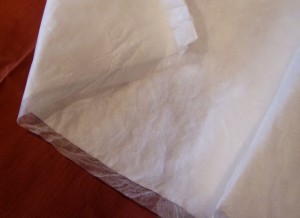 There are a couple of issues when you are creating a zip-out lining for a raincoat.
There are a couple of issues when you are creating a zip-out lining for a raincoat.
1. How are you going to be using this garment? Going to work? A child’s garment for going to school or play? Casual wear?
2. How much movement is involved? (more…)
Raincoats: facing zipper – Part One
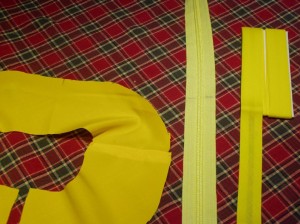 When you are making a zipout lining, the facing with the zipper attachment is where ‘the rubber meets the road’. I’m sure there are other methods of doing this, but this is what works for me. What you will need is what is in the top photo: a finished coat facing (this is a separate back collar facing and front facing, sewn together at the shoulders), a separating zipper as long as you can get it and some wide bias binding. Now, you don’t have to have the zipper or the binding match the facing –you can make the bias binding out anything you’d like – more raincoat fabric, contrasting fabric, the fabric you are using for the raincoat lining itself and so on. Fold the zipper in half and mark both sides of the tape with a pen for your center. Also fold the back neck facing in half and mark that one with a pen for THAT center as well; you’ll want to do this so that you can match up the center points on the zipper and the back neck facing.
When you are making a zipout lining, the facing with the zipper attachment is where ‘the rubber meets the road’. I’m sure there are other methods of doing this, but this is what works for me. What you will need is what is in the top photo: a finished coat facing (this is a separate back collar facing and front facing, sewn together at the shoulders), a separating zipper as long as you can get it and some wide bias binding. Now, you don’t have to have the zipper or the binding match the facing –you can make the bias binding out anything you’d like – more raincoat fabric, contrasting fabric, the fabric you are using for the raincoat lining itself and so on. Fold the zipper in half and mark both sides of the tape with a pen for your center. Also fold the back neck facing in half and mark that one with a pen for THAT center as well; you’ll want to do this so that you can match up the center points on the zipper and the back neck facing.
Step one: Attach the binding to the outside edge of the facing.
What we are doing is attaching something on the outside edge of the facing (which is where the zip out liner is going to attach), which is studier than the raincoat fabric is by itself, in order for the zipper to remain stable. So, what you do is unfold one side of the tape and do it ‘right side to right side’ on the edge and sew it down. Then fold it over, not quite in half – all you are looking for is to cover the raw edge of the facing. You should end up with something that looks like this. 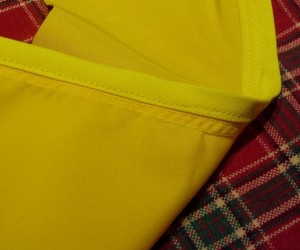
Step two: Match up the center of the binding with the center of one half of the zipper.
Unzip the zipper and lay the binding on one half of the zipper so that it just covers the teeth on the zipper tape. One of the functions of the bias binding is to do this so that you don’t have the teeth exposed when you are wearing the coat without the zip out liner. It should look something like this. 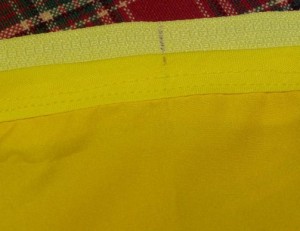
Step three: pin the zipper tape through the binding.
After all the ‘don’t make any more holes in the raincoat fabric than you absolutely have to, I’m breaking my own rules here. This is inside and so the whole waterproof-ness of the outside is not compromised by this and it helps hold the whole thing together because you are going to sew the zipper tape to the binding by hand. Yes, I know there are folks who hate, hate, hate hand sewing. As I said, I’m sure there are people who do this by machine, but I do not.
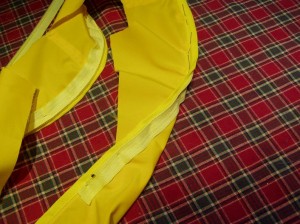 The way I do this is that I go back to the center match up and pin there and then work to the left and right pinning until I get to either end. Sounds crazy, I realize, but with something as long as this, I want to make sure I don’t end up with ‘crawling’.
The way I do this is that I go back to the center match up and pin there and then work to the left and right pinning until I get to either end. Sounds crazy, I realize, but with something as long as this, I want to make sure I don’t end up with ‘crawling’.
Step four: Baste down this half of the zipper.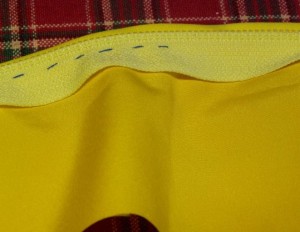 Again, just as with the pins, I start basting in the center back point and baste one half side down to one end and then go back and baste down the other half side all the way down to the end. This will prevent the zipper ‘crawling’ out of synch. Now that I have this firmly attached to the bias tape at the edge, I will pull out the zipper foot on my machine and sew that half of the zipper down.
Again, just as with the pins, I start basting in the center back point and baste one half side down to one end and then go back and baste down the other half side all the way down to the end. This will prevent the zipper ‘crawling’ out of synch. Now that I have this firmly attached to the bias tape at the edge, I will pull out the zipper foot on my machine and sew that half of the zipper down.
In Part Two, I will make the zip-out liner itself and attach the other half of the separating zipper to that and put the facing into the coat.
Raincoat: Pockets
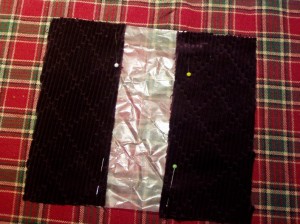 One of the things about making outerwear is having the ability to customize. Want a purple ski jacket? You can do it. Want a jacket with a ‘poachers pocket’ in the back? No problems. Want a jacket with vertical chest pockets with zippers so that you can put a bottle of penicillin and keep it warm if you have to doctor sheep out in the barn in January and it’s 0 degrees F out there? Yep. You can do that too (speaking of which, I used to have a lovely jacket from Woolrich, unfortunately colored pink, which ended up as a barn coat for precisely that reason. Trying to draw liquid antibiotics out of a bottle through a rubber stopper with a syringe when it is under 30 degrees is like trying to suck roast beef through a straw (more…)
One of the things about making outerwear is having the ability to customize. Want a purple ski jacket? You can do it. Want a jacket with a ‘poachers pocket’ in the back? No problems. Want a jacket with vertical chest pockets with zippers so that you can put a bottle of penicillin and keep it warm if you have to doctor sheep out in the barn in January and it’s 0 degrees F out there? Yep. You can do that too (speaking of which, I used to have a lovely jacket from Woolrich, unfortunately colored pink, which ended up as a barn coat for precisely that reason. Trying to draw liquid antibiotics out of a bottle through a rubber stopper with a syringe when it is under 30 degrees is like trying to suck roast beef through a straw (more…)
Raincoats: Using Seam Sealing Tape
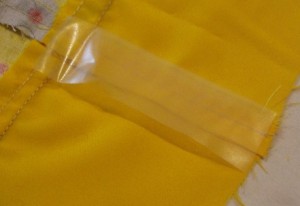 Unlike other sewing posts here on KCE, I’m not doing this coat in chronological order — we’ve all got our ‘big sewist panties’ on and I don’t think we need that. What this series is all about is the very specific items or skills which make working with something like a raincoat or water resistant fabrics different or new. It will all come together at the end, I promise.
Unlike other sewing posts here on KCE, I’m not doing this coat in chronological order — we’ve all got our ‘big sewist panties’ on and I don’t think we need that. What this series is all about is the very specific items or skills which make working with something like a raincoat or water resistant fabrics different or new. It will all come together at the end, I promise.
There are, as I’ve discussed before, several different ways to seal the seams on raincoats or other outerwear made with waterproof or water resistent fabrics:
Seam sealer which is squeezed out of a tube and painted on the seams with a brush (with which, to be honest, I don’t have any experience);
Seam sealing tapes, which is the point of discussion here. (more…)
Raincoat: Things to remember
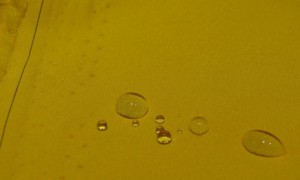 When working with ‘outdoor’ fabrics, it’s really useful to remember a couple of things:
When working with ‘outdoor’ fabrics, it’s really useful to remember a couple of things:
Unless you know otherwise, the fibers are man-made and will MELT at temperatures used to iron. Period. (more…)
Making outdoor clothing: Sources and Resources
Now, after I posted the last bit about what I’d do next, I realized that I didn’t have the proper zippers to do the demonstration, so I ordered them (I use Wawak because they have the largest collection and selection of zippers that I’ve ever seen and their service is really fab) and while I’m waiting for those to arrive, I’ll cover a couple of other issues and items that I think you might find useful.
First – if you have never worked with waterproof or water resistant or DWR (which stands for durable water resistant) fabrics before, this is totally new. I remember the first time I did this, all I could think of was that everything I ever knew about sewing in terms of pressing, laying out and so on was utterly useless with these fabrics. Why? Well, first of all, they are made of manmade fibers – polyester or nylon usually and they have a very low melting point which means that ironing the seams down except for when you are doing ‘seam sealing’ (which you WILL want to do), is a no-no. Secondly, there are a couple of different ways that fabrics are made water resistant/waterproof: coatings on the top (which usually makes them shiny, like laminated cottons) or coatings/waterproof membrane layers on the inside, which depending on the fabrics, can also require that you use a lining on the inside to protect them from abrasion from what the person is wearing inside the coat. There are 2-layer systems (which usually require some sort of inside lining of nylon taffeta or mesh), 3-layer systems (which may or may not require some sort of inside lining). There is even something referred to as 2.5 layer (which does not require a lining). I’m still trying to figure out what half a layer is. (more…)
Making a raincoat with a removable liner
 One of the clothing items that I think is really in the ‘must have’ category is a good solid raincoat with a removable liner. This is something that will carry you basically through most of the year except for the heat of the summer, when frankly, if you are caught in the rain, you are more likely to use an umbrella than a coat. So, from a ‘cost per wearing’ this is a terrific investment piece with a great return. (more…)
One of the clothing items that I think is really in the ‘must have’ category is a good solid raincoat with a removable liner. This is something that will carry you basically through most of the year except for the heat of the summer, when frankly, if you are caught in the rain, you are more likely to use an umbrella than a coat. So, from a ‘cost per wearing’ this is a terrific investment piece with a great return. (more…)
